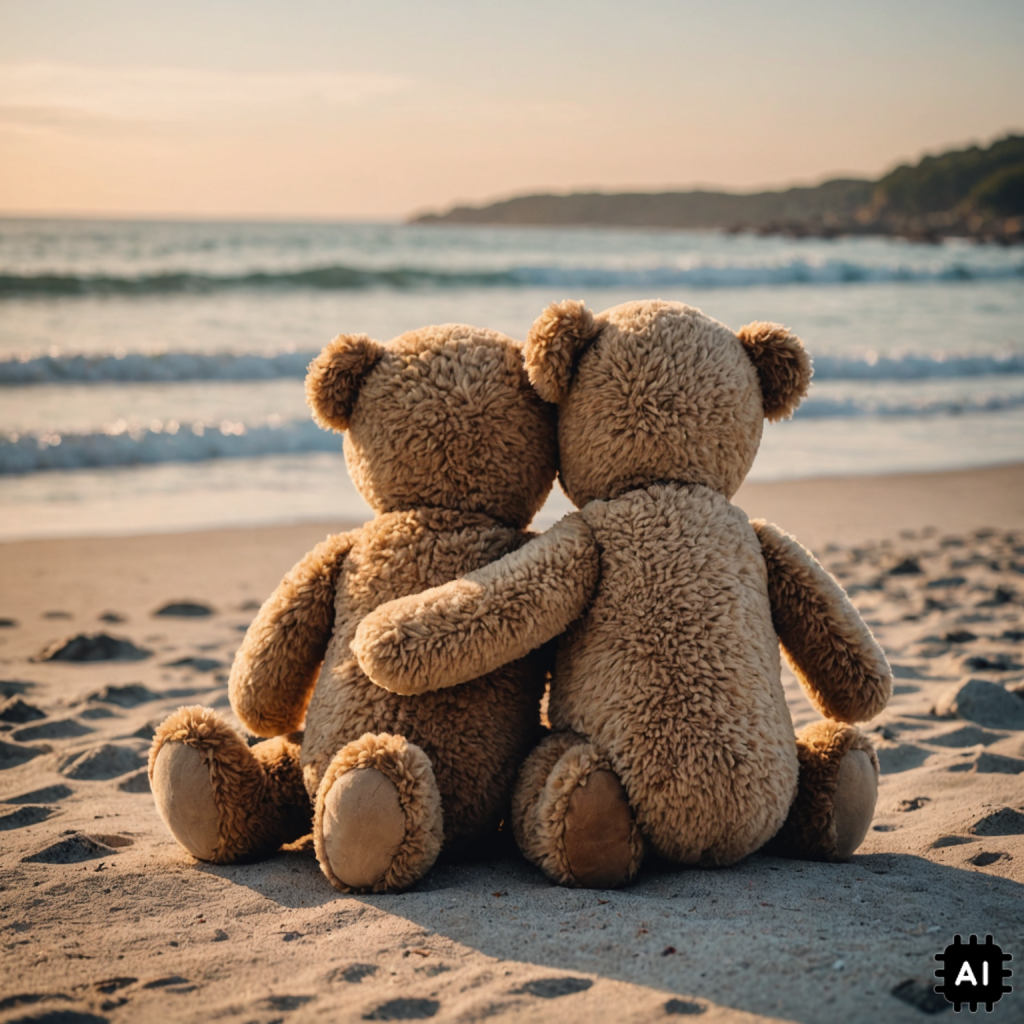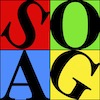
Earlier this summer, eight members of the gallery met to share their thoughts about art created using generative AI. Below is a summary of our discussion. We hope to start a discussion on the blog about this issue.
The image above was created in ~ 5 minutes by Margy using the prompt, “Teddy bears hugging on a beach.” Do note the disturbing placement of their legs!
HARRY
I see generative AI as a new tool. Most of the images currently being created by AI are rather silly but eventually someone will create great art with it.
I feel like we’re at an 1839 moment—the year photography was invented. At the time, painters were not happy about it, but it allowed painting to move away from realism into impressionism and abstraction. Eventually photography became accepted as art. Similarly, AI could nudge us in new directions. Like any art, successful AI will depend on the ideas behind the work and the context it is shown in.
I don’t think AI is a threat to SOAG at this time. We have strong filters in place. New members are thoroughly vetted. Work coming into the juried shows is evaluated by numerous members before it is accepted. SOAG is not at risk of being overwhelmed by AI. I would be in favor of allowing AI submissions to juried shows as long as it is identified as AI generated work. Whether it gets accepted is up to the members jurying the shows.
SOAG could use AI to generate discussion. Maybe we could invite someone using AI to the 2025 Invitational Show.
MARGY suggested we do an AI themed member show in the Salon—that would be fun.
DANIEL:
First, since there is a lot of misconceptions, we should agree on what AI is. Many think that if a computer is involved in the creation of an image then that is AI. I propose that when we talk about AI we are referring to generative AI (unless otherwise specified). Generative AI art is an image that is entirely machine created, based on text prompts. It is based on billions of images, most scraped from the internet. These are digested by machine learning algorithms and the output is an image that has no human creative participation.
We all expected there to be many AI submission to the gallery from outside artists but as it is now there is no reason members cannot submit AI for exhibit.
Do our current standard for membership requiring creativity and imagination somehow eliminate AI? Do we need to review our standards to include or deny the use of AI?
ETHEL was mainly opposed to AI and questioned how we could attribute authorship to an individual who shows AI when it is an amalgam of ideas from other people and sources?
MARGY Are there copyright issue we need to explore?
Daniel was concerned about the eliminations of creative jobs, and stress on our electric grid with so much AI coming.
Daniel is not thrilled about the AI “revolution” but feels it will be unstoppable and will be a big part of art and design in the near future. Margy believes that is an overstatement: that there will always be those who take pleasure in the physical act of creating.
Should we have a separate category for AI in our shows?
Everyone felt AI art should have explicit labeling.
Ed Harry and Vince felt something important is lost in the “craft” of making art using AI.
Harry and Vince said we should just let AI be submitted and then to judge it on the current standards of the gallery. If it is good art by our standards.
Are our current standards for membership and showing enough to cover AI?
VINCE suggested then that we have a process to review , as a gallery — as– members- our feelings, ideas and definitions or what good art is and what our standards are. All agreed this would not be easy and consensus would be difficulty. Vince suggested something worthwhile might come of the process especially since we will all not agree but will express our differences.
Are our current standard for membership and showing enough to cover AI?
We hope other members will weigh in with their thoughts on the issue!

There’s already been a long and multi-member email discussion. If any of you missed that, or would like it forwarded, I think Vince can do that on request. Margy’s summary of our Zoom meeting shows that the same concerns or questions about AI are in the minds of many of us. I was at that meeting, but I’ll take this opportunity share personal reactions to some of the ideas expressed. Overall, I agree with virtually everything discussed: what constitutes generative AI and distinguishes it from “older”digital creative tools; how can we (and should we?) integrate AI material in juried shows or contributions from members. I think a clearly expressed descriptions of the materials, methods, and software used to generate AI pieces are an absolute requirement. Leaving decisions of how to evaluate AI up to jury members begs the question of whether it belongs in a distinct category or considered along with traditional media. In my mind there’s a difference between artists demonstrating a mastery of a medium(s) and the product of generative AI. If mastery is considered, it belongs first to the programmers developing the software, and secondarily to the more minor manipulations and changes that an AI user can do to tweak the final output. As noted in the meeting summary, I believe that craft is a strong component of the artistic process and it is inherent in the art “product”. Things are changing very rapidly, and I have no doubt the soon generative AI will be capable of producing 3D and 2D final products in virtually any conceivable traditional medium. Robots will be able to paint, sculpt, and construct.
Okay, I’m starting to ramble here, so let me share a few ideas I’ve gleaned from some readings.
1. Yes, there are copyright and attribution issues inherent in generative AI. I don’t think that’s a problem the gallery can solve and there little evidence that there’s a simple way to deal with it. Virtually no one even seems to be trying, except for individuals or entities that are attempting to limit access to proprietary material
2. Generative AI, in only combining pre-existing data or images depends on user commands or suggestions. The AI process or “mind” has no insight, psychic structure, experience, or emotion to draw upon or express. There is art or creativity in the prompt or tweaks, but the initiation is more akin to poetry than visual art. The final product could just as easily a long textual description instead of an image. Sorry, rambling again. Lol
3. Some refer to AI as “artificial art”. It’s only a simulation of an artistic aesthetic.
4. The AI creator can make prompts, but cannot predict the outcome or sources that will be incorporated in the output. I suppose some traditional art may also be more happenstance or unpredictable as it develops.
5. To my mind “art” is a process, not simply an end product that resembles a painting, photograph, print, or sculpture.
6. Determining what is “good” or “bad” AI is can be highly dependent on the sophistication (and cost) of the software involved. This is unlike “traditional” art where a pencil and piece of paper may be all that’s necessary to create great art.
7. AI output can be produced in a matter of seconds, bypassing time consuming efforts, contemplation, and other elements of the typical artistic experience.
8. I am willing to give AI a chance, but within boundaries that keeps it as a separate category. I guess I’m a traditionalist at heart.
Something else occurred to me the other day. Are we starting to see the visual art equivalent of the electronic music development of a few decades ago? I’m talking about auto-tuning for voices and synthesizers for instruments. Still music art? Good music? Are the products of these developments judged (or awarded) along with humans singing or making music with actual instruments?